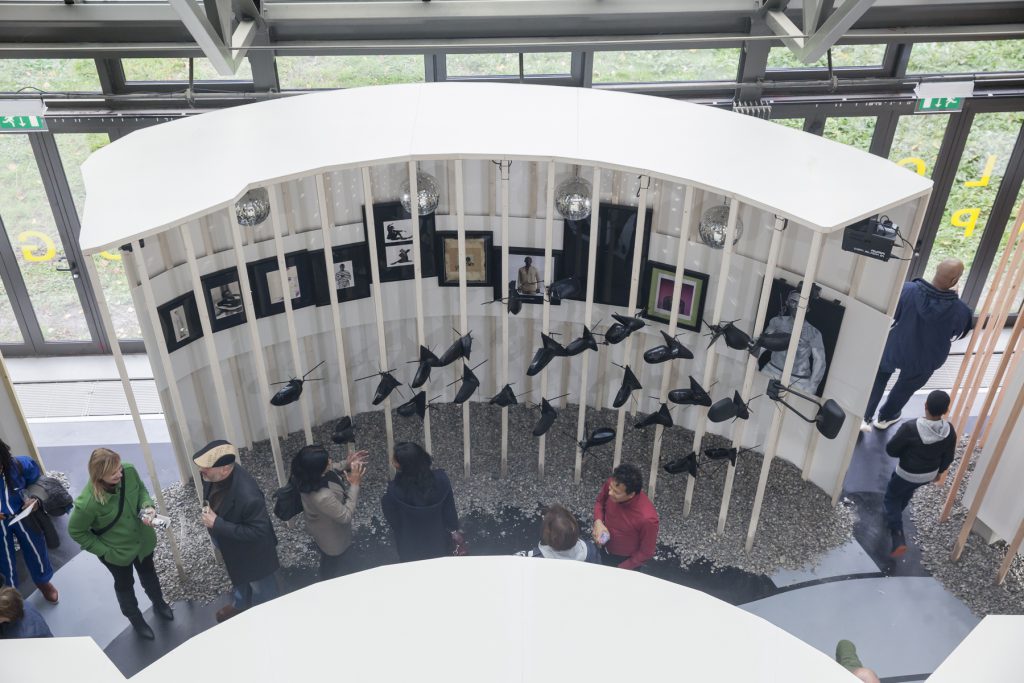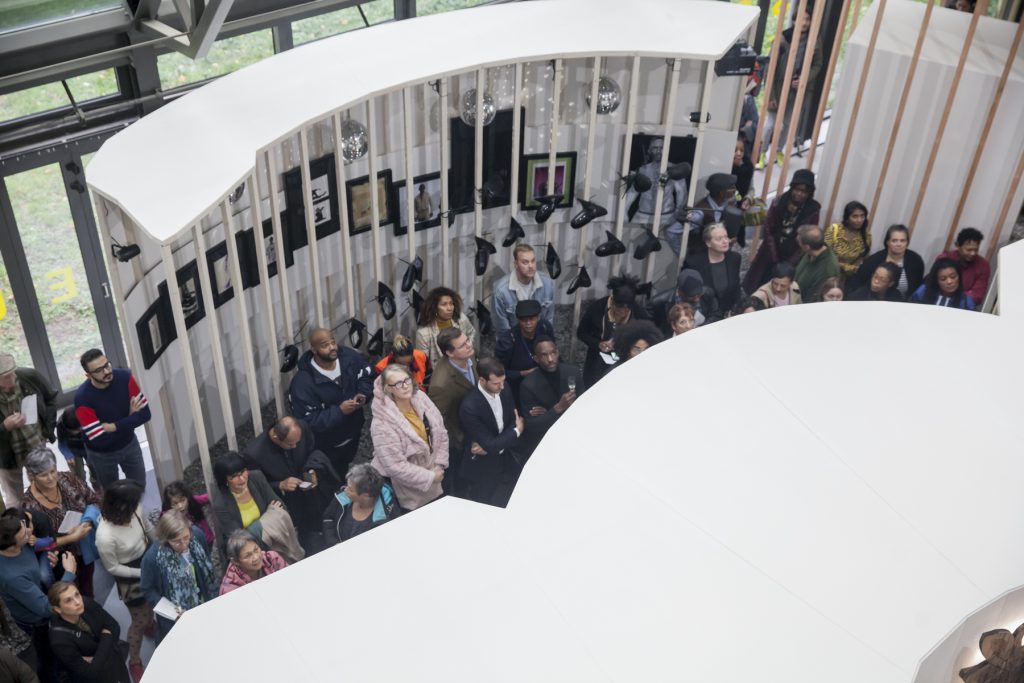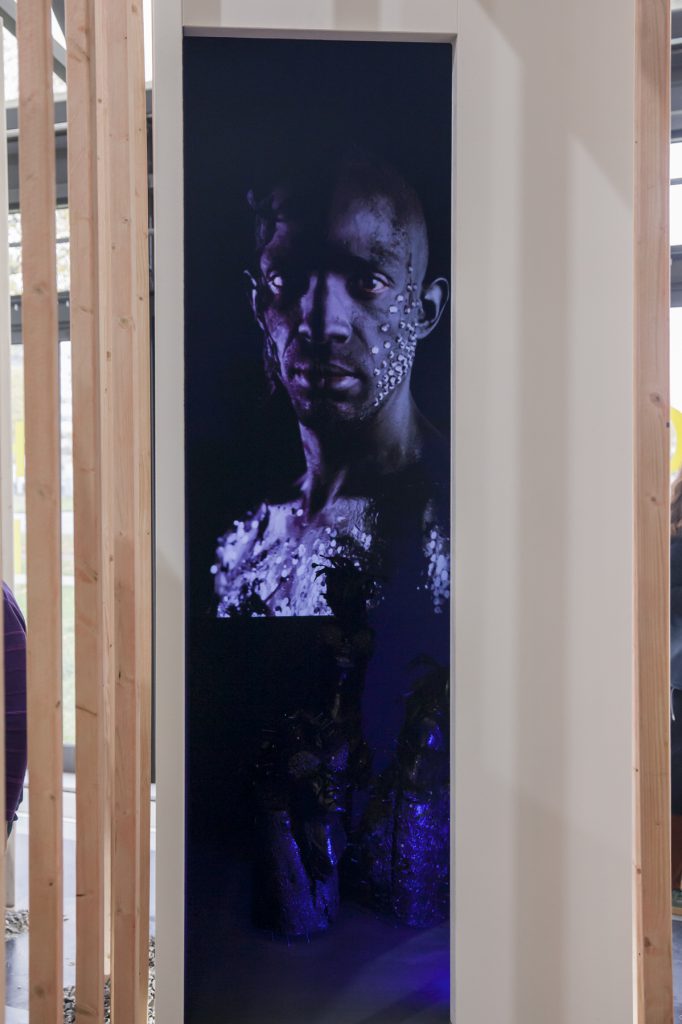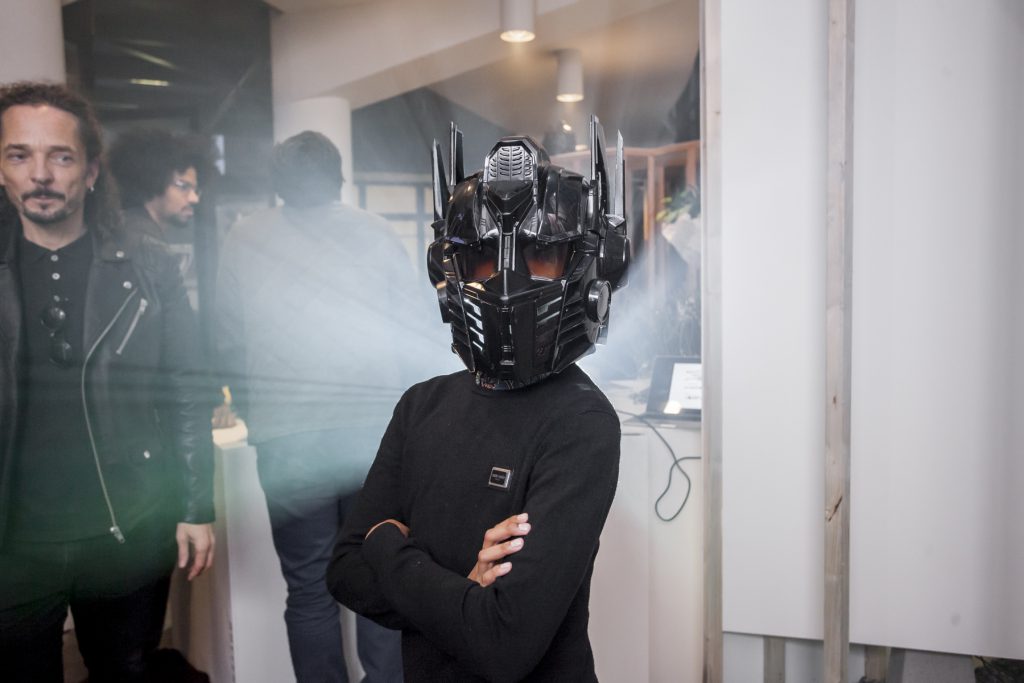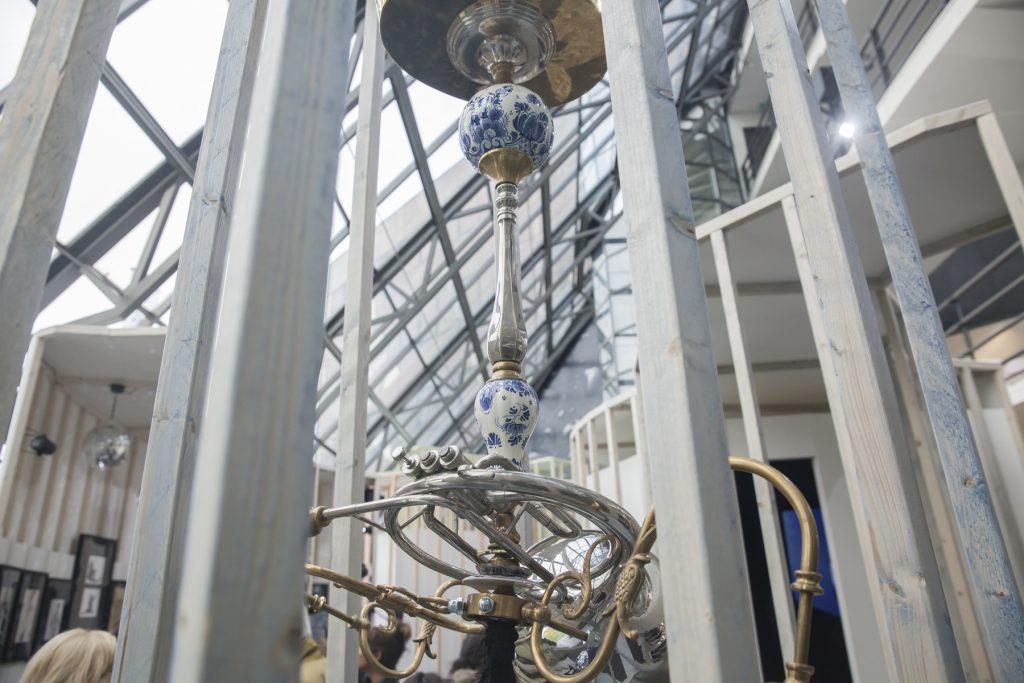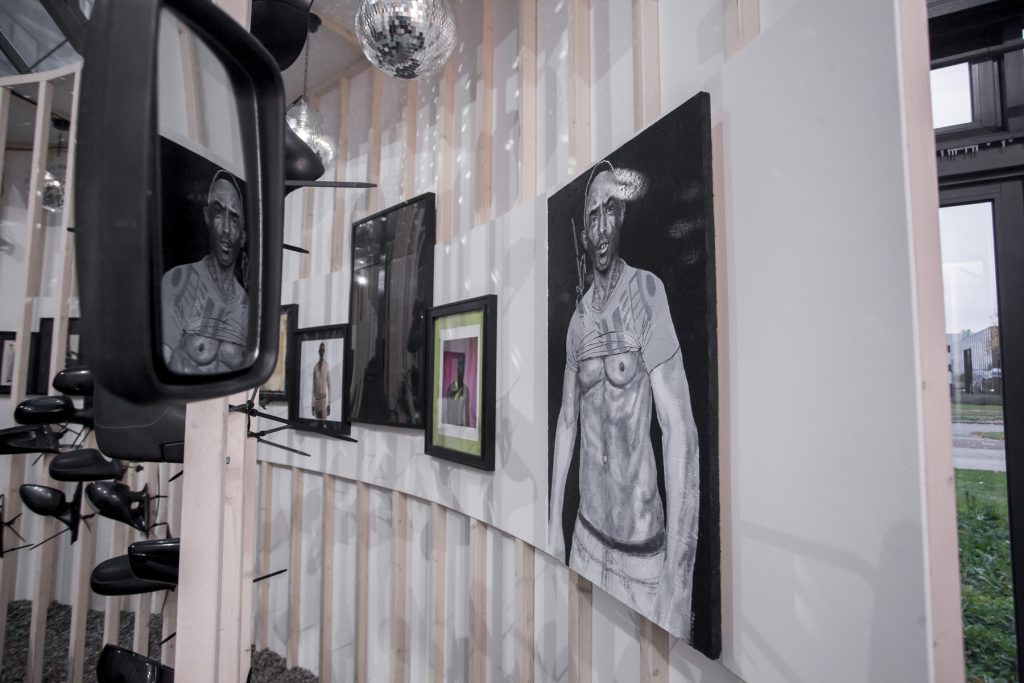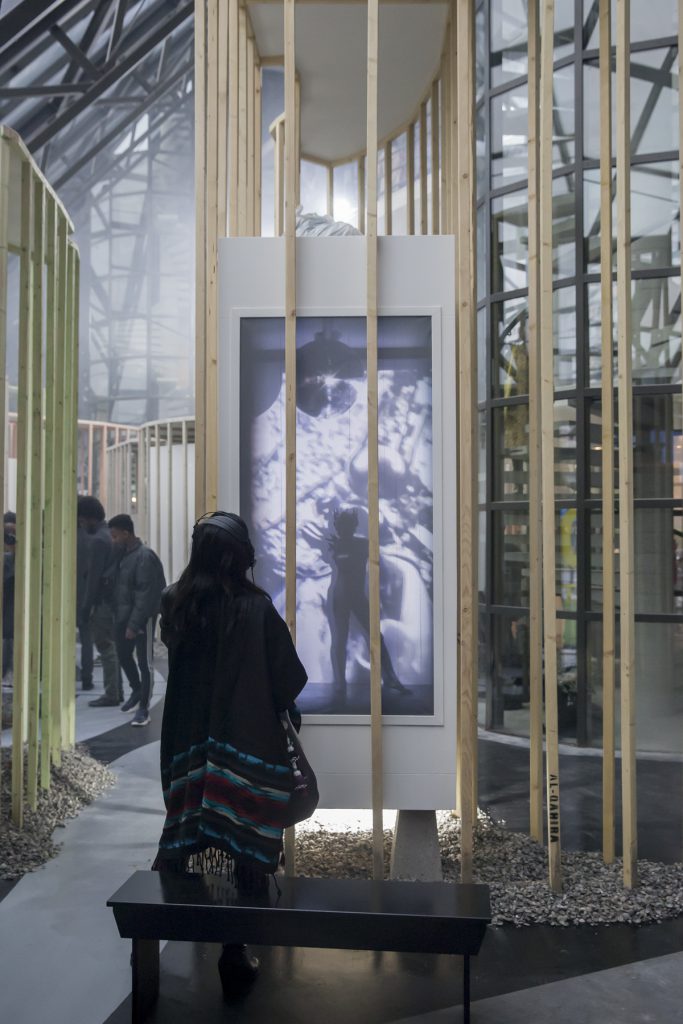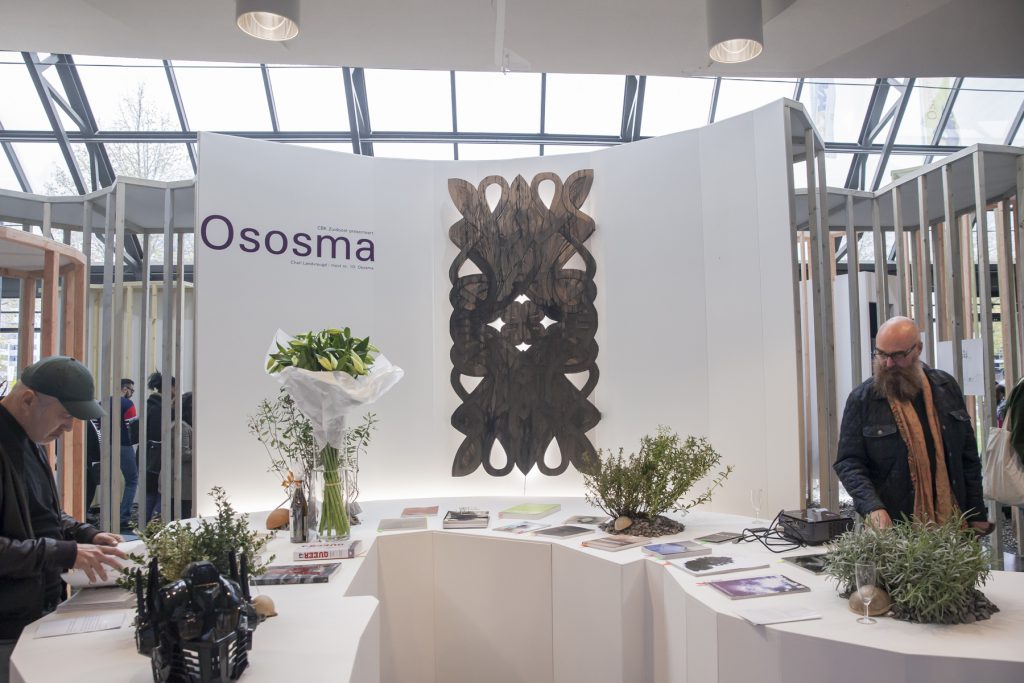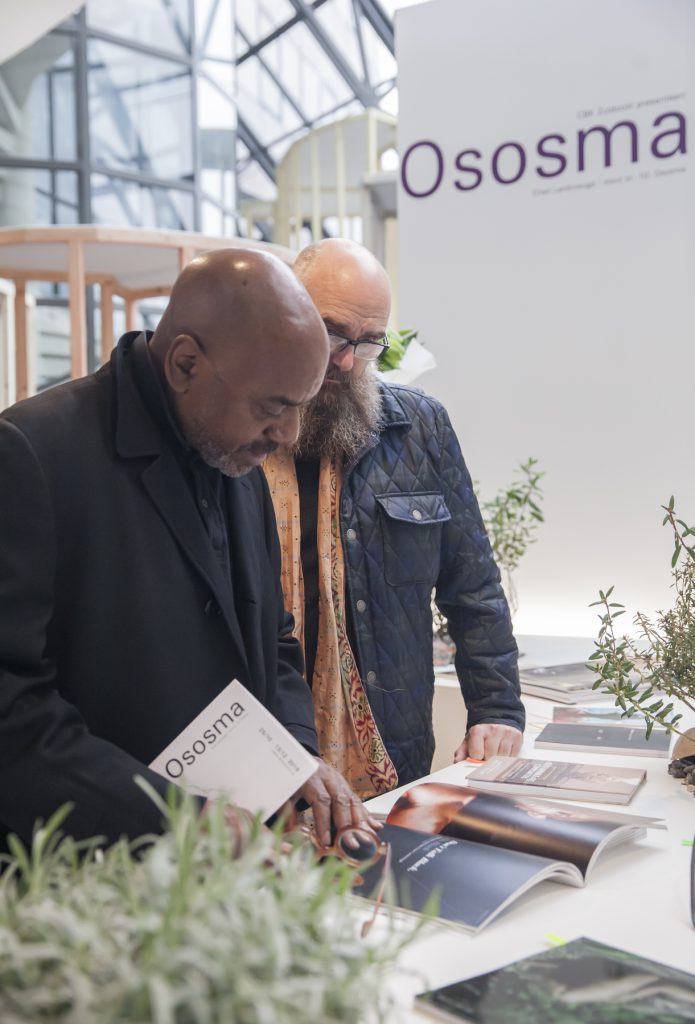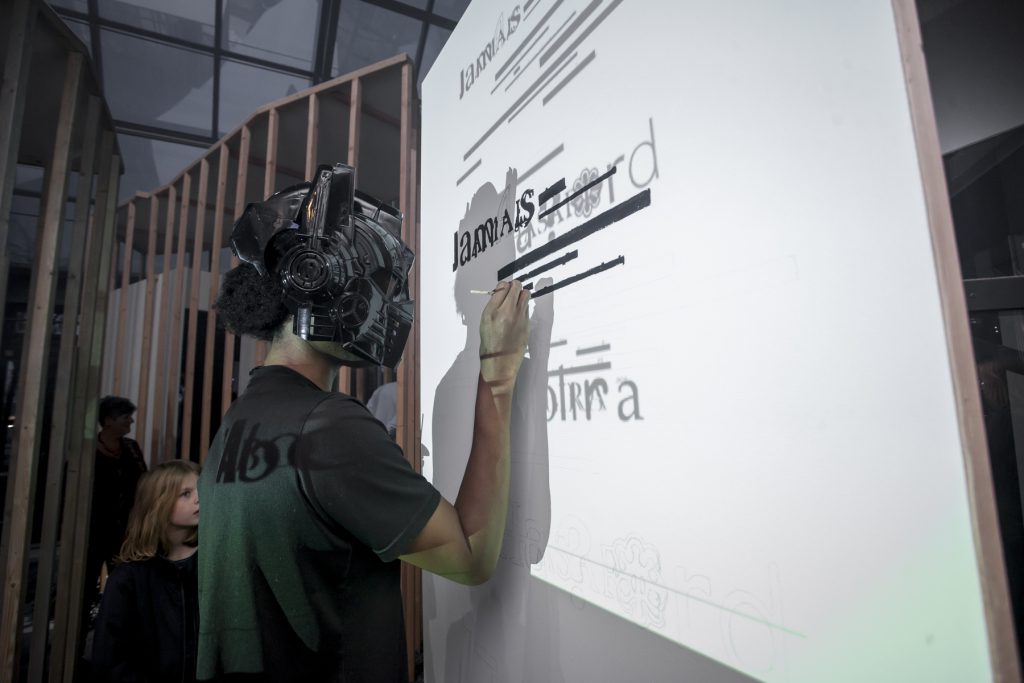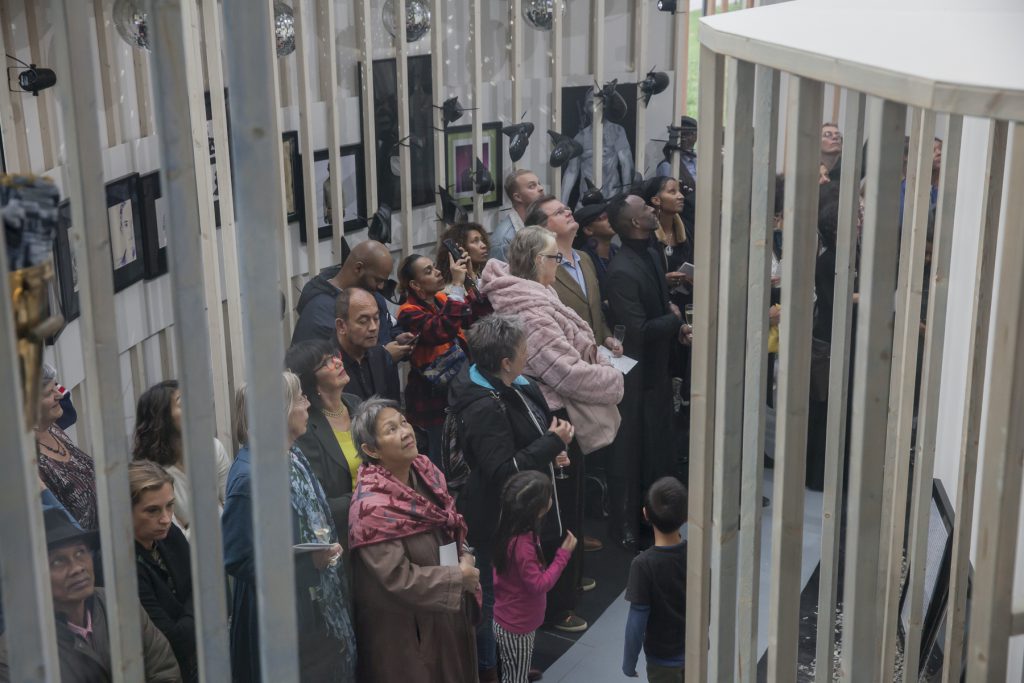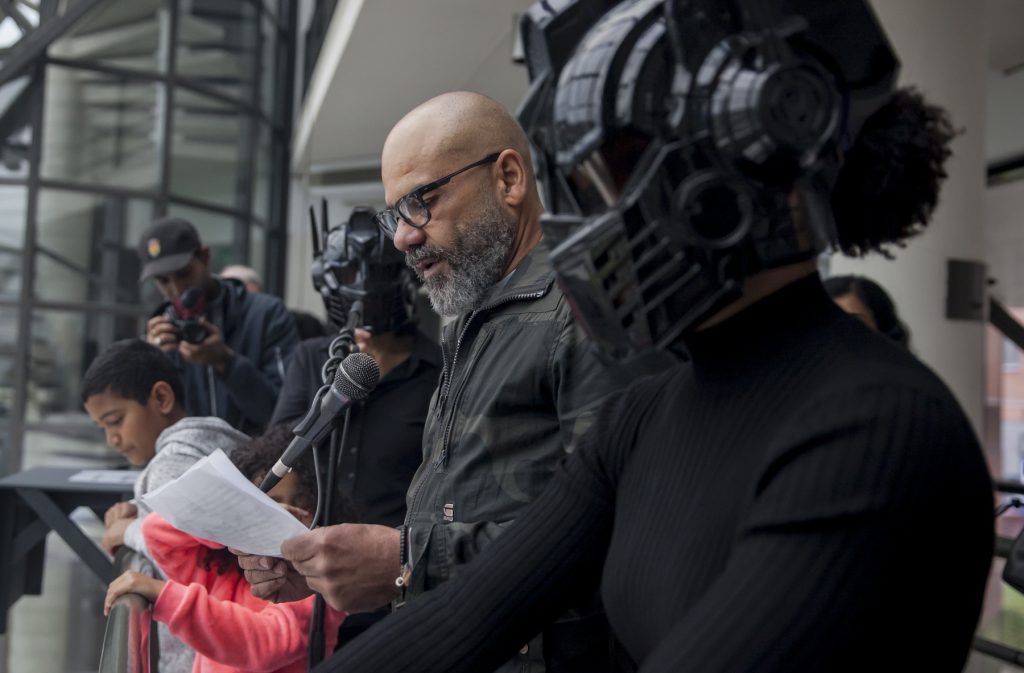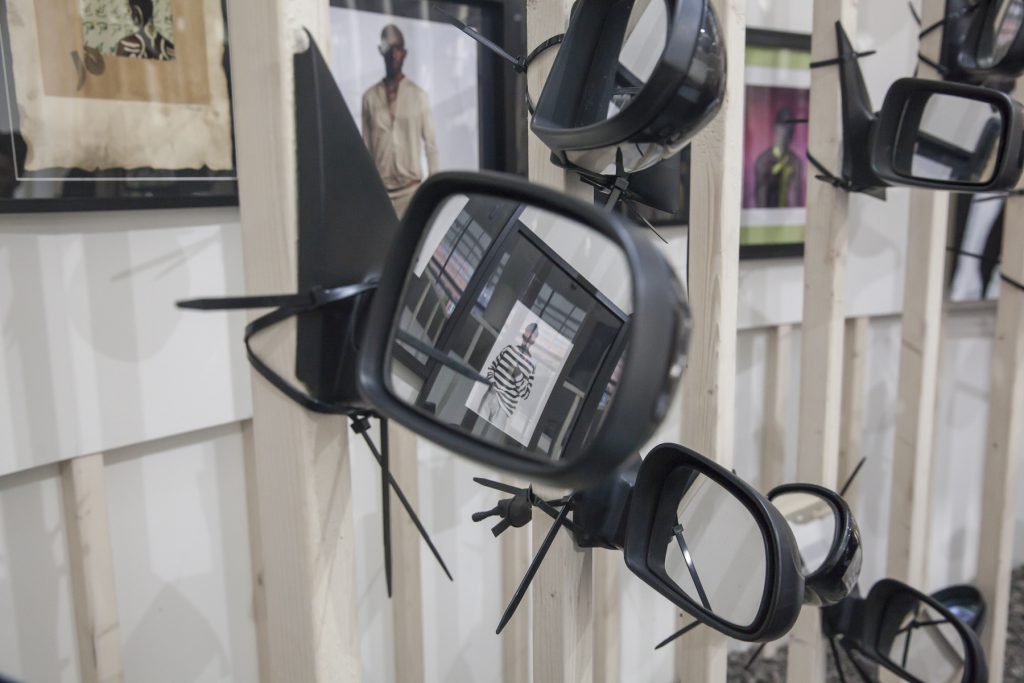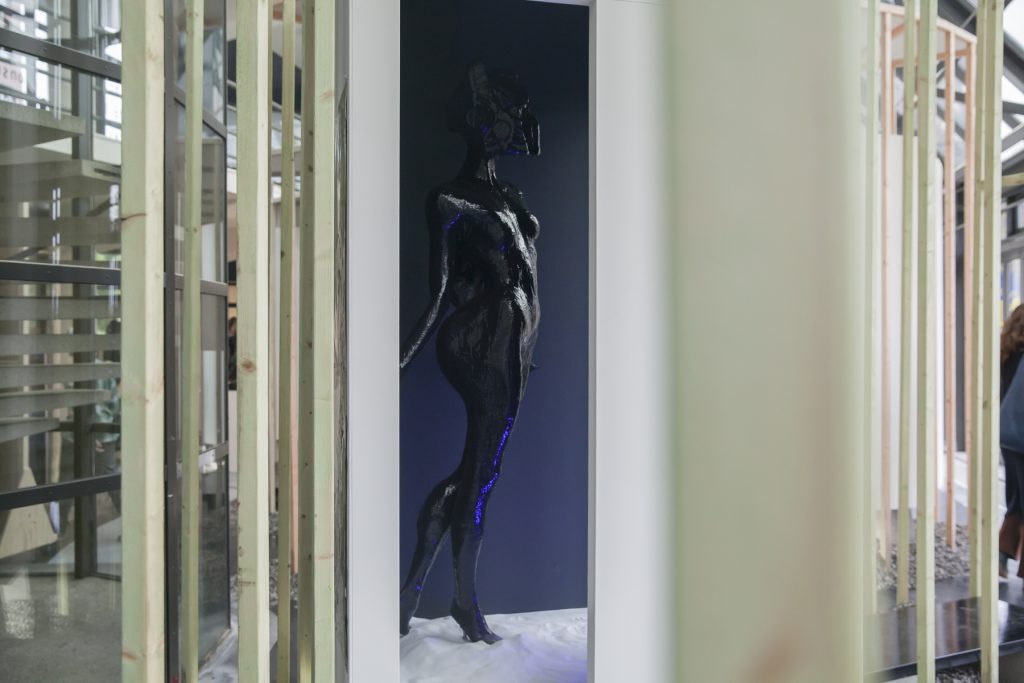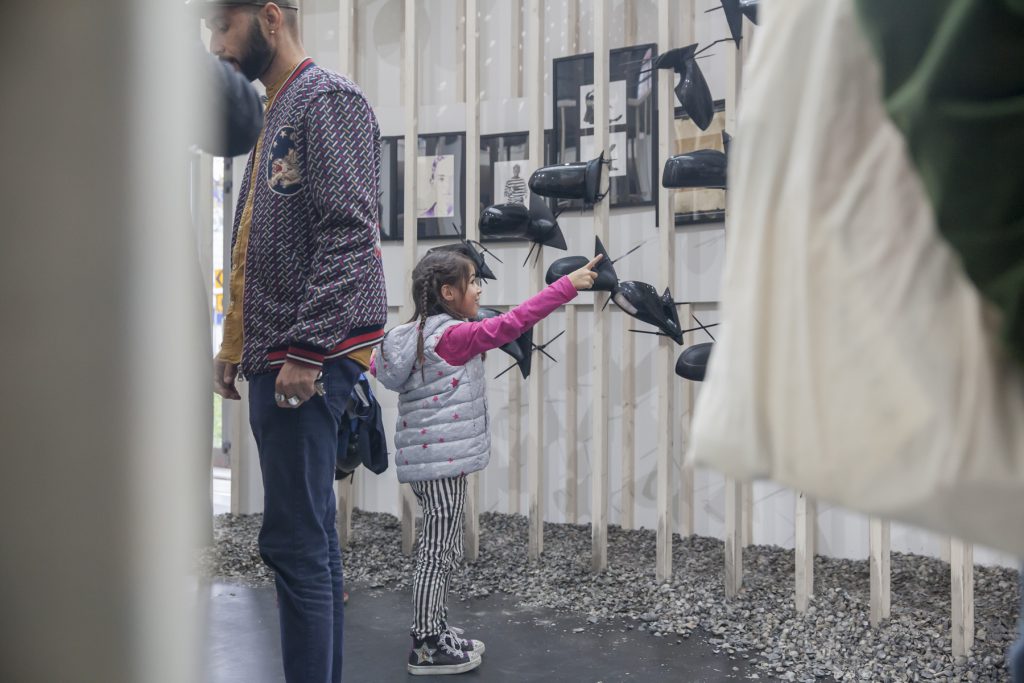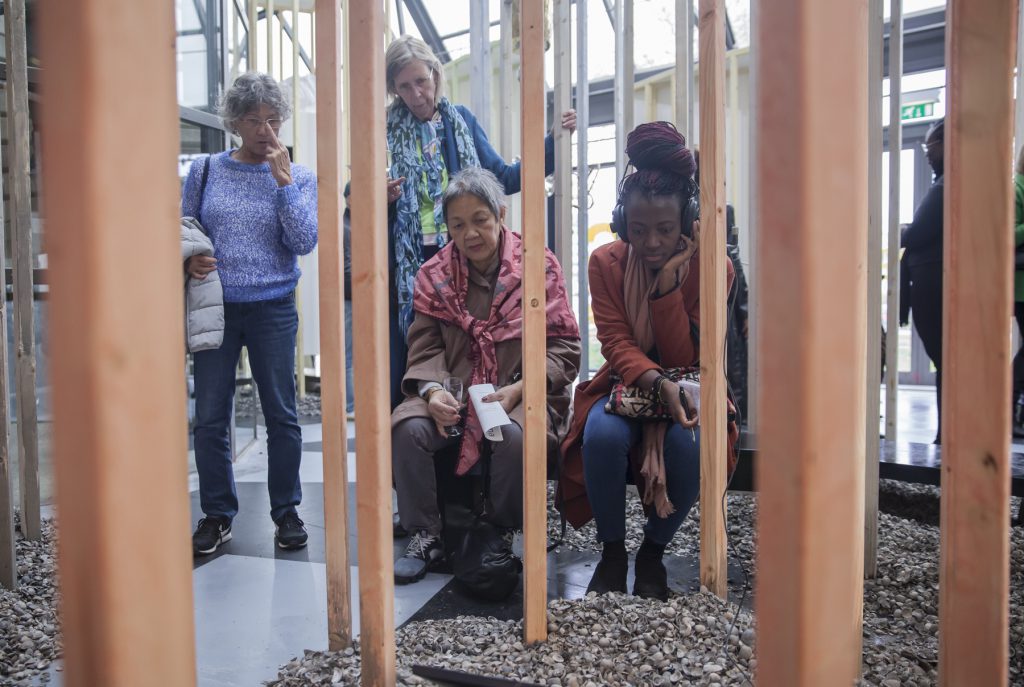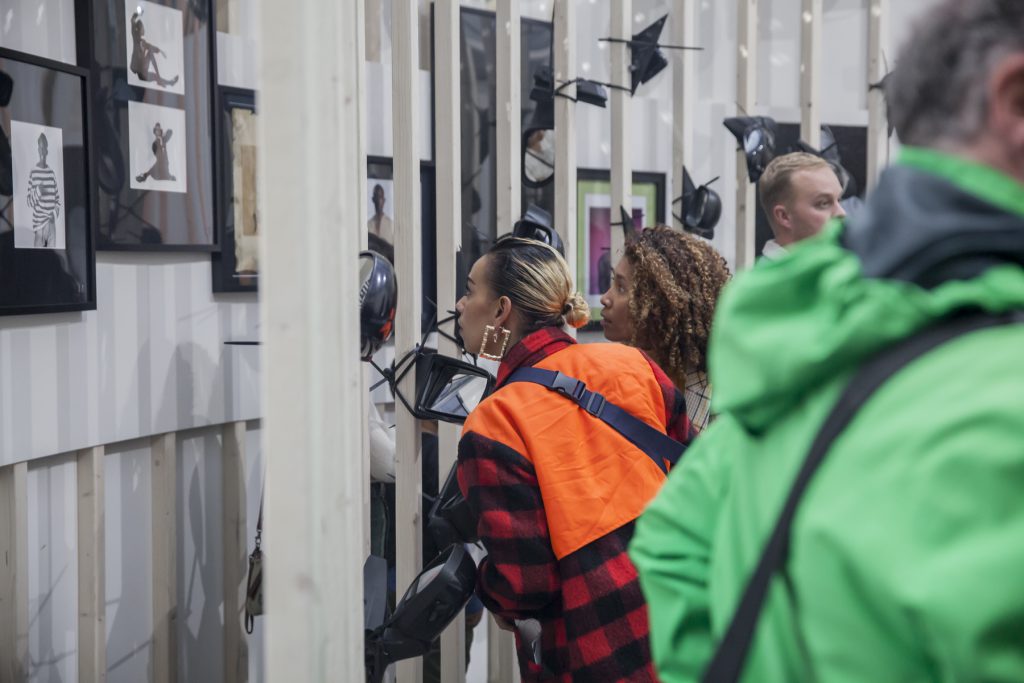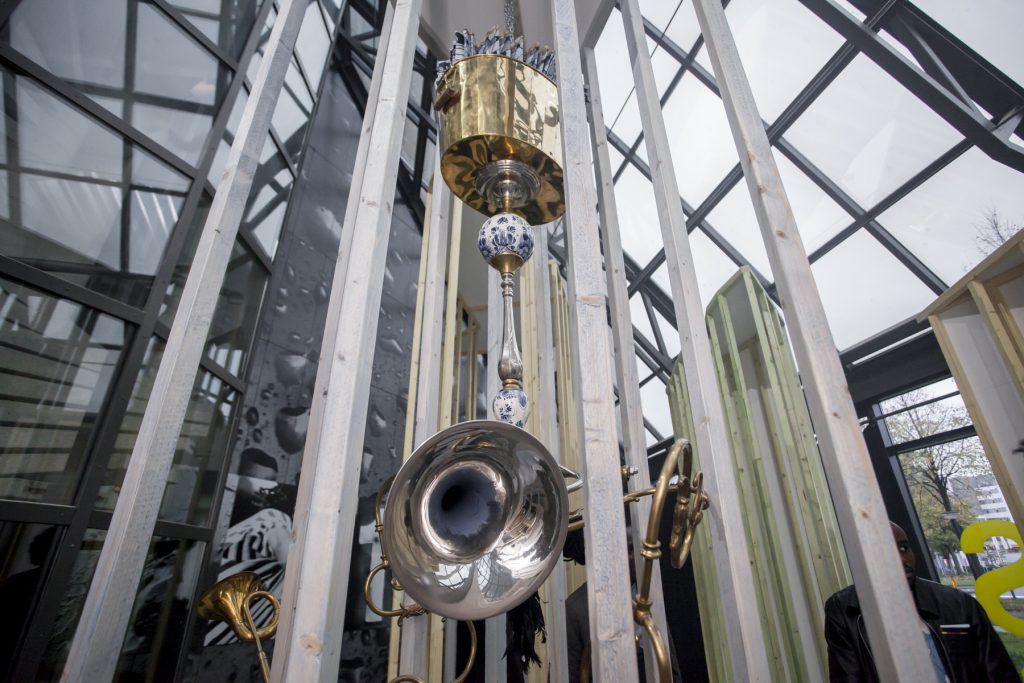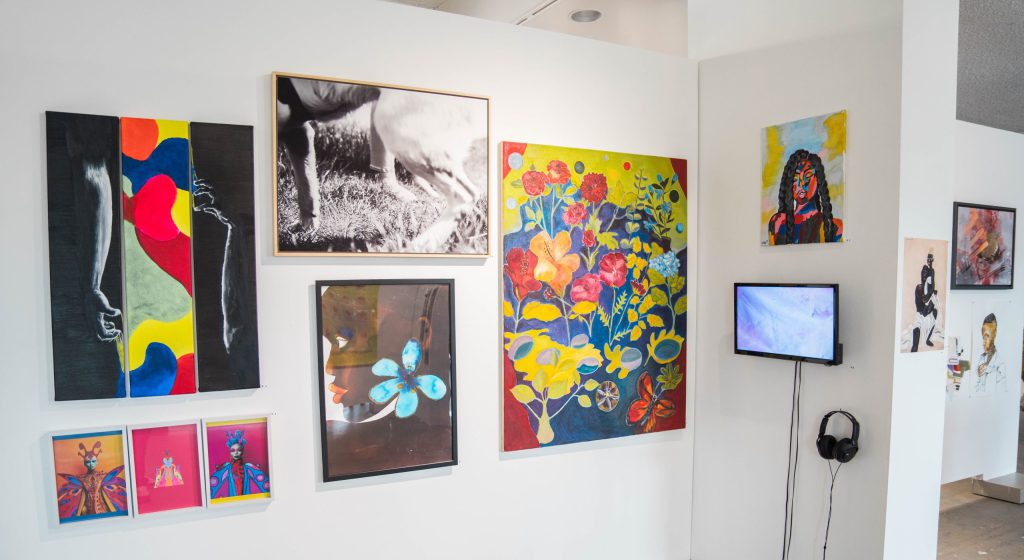Movt. nr. 10 Ososma
Wanneer: 25 oktober 2019 - 13 december 2019
Kunstenaars
Charl Landvreugd
Movt. nr. 10 Ososma is een monumentale solo-expositie van Charl Landvreugd speciaal gemaakt voor deze locatie. Het is een nieuw grootschalig werk en tegelijkertijd óók drager van bestaand en ander nieuw werk van de kunstenaar.
De presentatie is een gelaagd zelfportret van Landvreugd waarmee hij kritisch terugblikt op zijn wordingsproces als kunstenaar en reflecteert op waar hij nu staat. Ook is het een bevlogen commentaar op bestaande paradigma’s binnen de kunstwereld.
Transformatie is een sleutelbegrip in het werk van Landvreugd en daarmee ook in deze expositie. De mensheid is in een continue staat van transitie; personaliteit is nooit statisch of ‘puur’, maar wordt – bewust en onbewust – bepaald door ontmoetingen en gebeurtenissen in het verleden, heden en toekomst. Meer dan ooit accentueert Landvreugd met movt. Nr. 10 Ososma dat hybriditeit kenmerkend is voor onze contemporaine tijd en onze toekomst. Zijn praktijk komt voort uit de ruimte die ontstaat wanneer deze hybriditeit als vanzelfsprekend wordt beschouwd.
Ososma is de eerste van een reeks solotentoonstellingen van CBK Zuidoost. Als tegenhanger van haar reguliere programma in ‘eigen’ huis – met vooral groepstentoonstellingen – gaat de instelling de komende jaren solo’s van ambitieus formaat op locatie realiseren. Zo wil CBK Zuidoost specifiek inhoud ontwikkelen die in het museale circuit nog niet of met te weinig aandacht wordt gebracht. Inhoud die de interculturele samenleving van Nederland reflecteert en uitdaagt.
Over het werk Inspiratiebron voor movt. nr 10 Ososma is de traditie van tembe, een verzamelnaam voor houtsnijwerk en schilderkunst uit de Marroncultuur in Suriname. Meer nog, een tembe leverde letterlijk de plattegrond van de tentoonstelling. Een tweedimensionaal schilderwerk is door Landvreugd voor movt. nr 10 Ososma sterk vergroot en getransformeerd naar een drie dimensionale verschijningsvorm.
Vervolgens heeft Landvreugd de verschillende onderdelen van de tembe uit elkaar getrokken. Met losse elementen is een labyrint-achtige ruimte gecreëerd waarin de bezoeker op verschillende manieren kan ronddwalen en ontdekkingen kan doen. Elk los element is een paviljoen met nieuw of al eerder getoond en herschikt werk van Landvreugd. Er is niet één route; ieder kan zijn eigen weg zoeken. Sommige doorgangen zijn krap, andere zijn breder en nergens is overzicht over de totale ruimte. Behalve dan van boven, vanaf de tweede verdieping. Van daaruit wordt de tweedimensionale vorm van de tembe weer enigszins zichtbaar.
Op de begane grond stellen de verschillende losse elementen krappe kaders aan de kunstwerken die er worden getoond. De in of op de paviljoens getoonde kunstwerken krijgen weinig ruimte en men kan niet echt afstand nemen. Het geeft een benauwd en vervreemdend gevoel. Door te kiezen voor de tembe als uitgangpunt voor de expositieruimte, en voor een opstelling waar de werken min of meer ‘gevangen’ zijn tussen de spijlen van de verschillende paviljoens, neemt Landvreugd afstand van de museale ‘white cube’-opstelling, waarbij het kunstwerk alle ruimte krijgt en de bezoeker het werk makkelijk kan bekijken.
Bij Landvreugd valt de vorm van de tentoonstelling samen met de inhoud. Zijn werk gaat over transformatie, over beweging en ontwikkeling, maar ook over kadering en framing, en de wrijving die dat kan veroorzaken in de ontwikkeling van een persoon. De vorm van de tentoonstelling benadrukt deze framing en laat zien wat er gebeurt als er teveel kaders worden gesteld: dan is niet meer alles zichtbaar, dan wordt het benauwd, dan ontstaat de neiging uit de gestelde kaders te breken of om nieuwe kaders te scheppen. In die zin is movt. nr. 10 Ososma een verbeelding van de huidige tendens om nieuwe persoonlijke en sociale kaders te schrijven voor de 21ste eeuw.
De beeldtaal van het resultaat is paradoxaal; net als het oeuvre van Landvreugd. Hoe moeten we het lezen? welke connotaties zijn te maken? Waar hoort het bij: verwijst het naar antropologie of naar modernisme? Daarmee reflecteert movt. nr. 10 Ososma op het actuele kunsthistorische debat en wil het bijdragen aan een vernieuwd discours, een meer adequaat begrippenkader voor het duiden van kunst van nu.
Over de kunstenaar:
Dr. Charl Landvreugd (Paramaribo, Suriname, 1971) is een kunstenaar en onderzoeker die opgroeide in Rotterdam in een periode waarin veel verschillende migrantengemeenschappen van Nederland hun thuis maakten. Zelf onderdeel uitmakend van deze veranderende bevolkingssamenstelling, onderzoekt hij de kaders rondom het denken over de uitwerking van migratie op de toekomst en de hedendaagse cultuur. Als kunstenaar maakt hij gebruik van een breed scala aan artistieke disciplines, zoals sculpturen, installaties, video’s, performances en fotografie.
Landvreugd studeerde aan de Goldsmiths University of Londen en Columbia University in New York. In mei 2019 rondde Landvreugd zijn promotie-onderzoek af aan het Royal College of Art in Londen. Zijn proefschrift ‘Locating Afro artists as culturally native to the Dutch art world’ onderzoekt de vraag of het mogelijk is om kunstenaars met een migratieachtergrond als cultuureigen te beschouwen in het Nederlandse kunstlandschap. Sinds 2019 is hij lid van Akademie van Kunsten, een onderdeel van de Koninklijke Nederlandse Akademie van Wetenschappen. Zijn werk is getoond in Engeland, de Verenigde Staten, de Caraïben, Senegal en Nederland. Hij publiceerde in magazines als ARC, Small Axe, Open Arts Journal en in meerdere catalogi.
Credits
Opdrachtgever: CBK Zuidoost Kunstenaar: Charl Landvreugd Curatoren: Renske de Jong Vormgeving: Studio Balai Bouwteam: Woodworks Techniek: Warning Studios
Dit project is mede mogelijk gemaakt door: Ammodo, Amsterdams Fonds voor de Kunst, Gemeente Amsterdam, HOBU, Mondriaan Fonds, Stichting Hondsrugpark, Vastint
Movt. nr. 10 Ososma is a monumental solo exhibition by Charl Landvreugd, especially made for this location. It is a new large-scale work. At the same time, this exhibition comprises both existing and other new work from the artist.
The presentation is a layered self-portrait by Landvreugd in which he critically looks back on his genesis as an artist, and reflects on his current state of affairs. Also, it is an inspired commentary on existing paradigms in the art world.
Transformation is a key concept in Landvreugd’s work and, therefore, as well in this exhibition. Mankind is in a continuous state of transition; personality is never static or ‘pure’, but is — consciously or unconsciously — determined by encounters and events in the past, present, and future. More than ever, Landvreugd emphasizes in movt. Nr. 10 Ososma that hybridity is characteristic of our contemporary time and our future. His practice arises from the space that comes into existence when this hybridity is taken for granted.
Ososma is the first in a series of solo exhibitions at CBK Zuidoost. As a counterpart to the regular “in-house” program — mostly group exhibitions — the institution will set up ambitious solo projects at location in the following years. The organization aims to develop content that receives too little attention in the museum milieu; content that seeks to mirror and challenge the intercultural society of the Netherlands.
About the work
Source of inspiration for movt. nr 10 Ososma is the tradition of tembe, an umbrella term for woodcarving and paintings of the Maroon culture in Surinam. In fact, a tembe literally provided the ground plan for the exhibition. For Movt. nr 10 Ososma Landvreugd greatly enlarged and transformed a two-dimensional painting into a three-dimensional appearance.
Landvreugd subsequently took apart the different parts of the tembe. A labyrinth-like space is created with individual elements, a space in which the visitor can roam about and make discoveries. Every individual element is a pavilion with new or rearranged work by Landvreugd. There is not just a single route; everyone can find their own way. Some passages are narrow, others are more broad, and there is nowhere a general view of the whole space. Except for from above, from the second floor. From there, the two-dimensional form of the tembe becomes slightly visible again.
On the ground floor, the individual elements put a narrow framework around the displayed works of art. The works in — and on — the pavilions are in a tiny place and one cannot really take distance. It generates an oppressive and alienated feeling. By choosing the tembe as a starting point for the exhibition space, and an arrangement in which the works are more or less ‘caught’ between the bars of the various pavilions, Landvreugd takes distance from the museological White Cube set-up, in which the work of art is on display in a spacious room and the visitor can conveniently view it.
At this Landvreugd exhibition, form and content coincide. His work is about transformation, about movement and development, but at the same time about framing, and the friction this can cause in the development of a person. The form of the exhibition underlines this framing and shows what happens when too many frameworks are set up: not everything is visible anymore, it feels oppressive, and one feels inclined to break through the frameworks or to create new ones. In that respect, movt. nr. 10 Ososma is a representation of the current trend to come up with new personal and social frameworks for the 21st century.
The result of this is a paradoxical imagery; it is characteristic of Landvreugd’s oeuvre. How should we comprehend it, and what connotations come to mind? What is it part of? Is it referring to anthropology or modernism? In this way, movt. nr. 10 Ososma mirrors the current art historical debate and attempts to contribute to an innovative discourse, a more adequate conceptual framework to interpret today’s art.
About the artist
Dr. Charl Landvreugd (Paramaribo, Suriname, 1971) is an artist and researcher who grew up in Rotterdam in a period in which different migrant communities made the Netherlands their home. Being part of this changing population composition himself, he researches frameworks for thinking about the impact of migration on the future and on contemporary culture. As an artist, he uses a wide array of artistic disciplines, such as sculptures, installation art, videos, performance art, and photography.
Landvreugd studied at Goldsmiths University of London and Columbia University in New York. He finished his doctoral study at London’s Royal College of Art in May 2019. His thesis “Locating Afro artists as culturally native to the Dutch art world” examines the question whether it is possible to perceive artists with a migration background as an inherent part of the Dutch art scene. Since 2019, he is a member of the Akademie van Kunsten, a component of the Koninklijke Nederlandse Akademie van Wetenschappen. His work has been shown in England, United States, the Caribbean, Senegal and the Netherlands. He has published in magazines such as ARC Magazine, Small Axe, Open Arts Journal, and in various catalogues.
Credits
Assignment by: CBK Zuidoost
Artist: Charl Landvreugd
Curators: Renske de Jong
Design: Studio Balai
Construction team: Woodworks
Technique: Warning Studios
This project is made possible by:
Ammodo, Amsterdams Fonds voor de Kunst, Gemeente Amsterdam, HOBU, Mondriaan Fonds, Stichting Hondsrugpark, Vastint


